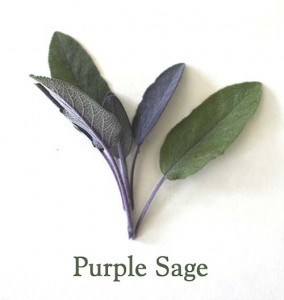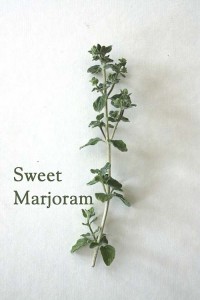Is there anything better than fresh herbs from the garden?
For years I had herbs in my fairly dry veggie garden. Some of the herbs herbs thrived. Others sulked. Some died.
Fortunately, if you’re trying to cut down on watering, you still have a huge number of herbs to choose from. For instance, many of the plants that you think of immediately when you hear the word “herb” originate in the Mediterranean, and many of them prefer less moisture than other garden plants.
Below, I’ve listed some common herbs that have done well for me dry spots, along with others that I’ve seen doing well in quite dry conditions. There are lots of other selections, but this list can get you going with more than a summer’s worth of recipes.
- Rosemary (Rosmarinus officinalis): You can pick from forms that sprawl, form a shrub, or grow straight up in spires.
 Sage (Salvia officianalis): European Garden sage comes in lots of versions in leaf color (green, golden, tri-color or purple) and flavor (“sage” flavor, pineapple, or grape).
Sage (Salvia officianalis): European Garden sage comes in lots of versions in leaf color (green, golden, tri-color or purple) and flavor (“sage” flavor, pineapple, or grape).- Oregano (Origanum vulgare)
- Marjoram (Origanum majorana)
- Thyme (Thymus spp.): Some thymes, including many of those sold for ornamental groundcover use (such as T. serpiphyllum) are only slightly scented or not at all. The culinary bush forms generally have more scent and flavor, and they come in a wide range, including lemon and lime. They also tend to be more tolerant of dry conditions.
- Lavender (Lavandula spp.): There are several lavender species, as well as plenty of hybrids and varieties. All are at least somewhat drought tolerant. Some extremely so.
 Scented geraniums (Pelargonium spp.): Take your pick of rose, apple, cinnamon, nutmeg, pineapple, lemon, lime, apricot and others.
Scented geraniums (Pelargonium spp.): Take your pick of rose, apple, cinnamon, nutmeg, pineapple, lemon, lime, apricot and others.- Wormwood (Artemisia spp.)
- Mexican oregano (Lippia graveolens)
- Fennel (Foeniculum vulgare): Beautiful and tasty plants, but they’re considered invasive in many locations (including the entire California floristic province). Research before you plant! There’s an attractive bronze version that’s reputed to be less invasive. Still, I wouln’t plant it if regular fennel is a problem in your area.
- Nasturtium (Tropaeolum majus): With edible, peppery leaves and flowers, some people consider this an herb. As with fennel, above, it can be invasive. Don’t plant it if it could escape. (Many of the moister hillsides here in San Diego are covered with the stuff.)
- Lemon grass, both West-Indian (Cymbopogon citratus) and East-Indian (C. flexuosus): Sources tell you these plants like water, but I’ve found that they don’t mind going dry occasionally, especially if they’re given some shade.
Good eats!


